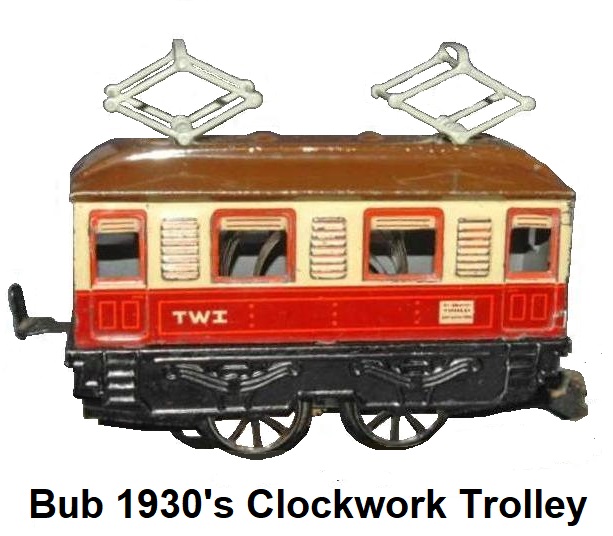 Karl Bub founded this company in 1851 in Nüremberg,
Germany. As all the other toy manufacturers in Nüremberg, Karl Bub intended his company to produce
merry go-rounds, fountains, carts, horse-drawn street cars, fire engines, and other tin toys both
with, and without mechanical (clockwork) drive units. American toy train collectors are familiar with
the 'KBN' trademark, which stands for 'Karl Bub Nüremberg'. Bub made a superbly enameled and later
lithographed line of clockwork tin transportation toys including trains.
They started making floor trains that ran by clockwork in 1903. Track
based trains came two years later in 1905. Then in 1914 an electric train was added to the product line.
The electrics were created in collaboration with Georges Carette et Cie.
KBN never produced live steam locomotives. The very first trains consisted of 2-2-0 clockwork engines and
open end passenger cars. The first models of both passenger and freight cars were
of typical Nüremberg 4-wheel design. These early trains were made in gauge 1 and 'O' gauge. The factory was
located at Gostendorfer Hauptstrasse 48. Karl Bub's daughter Emma married Albert Huck who eventually
took over the management of KBN.
Karl Bub founded this company in 1851 in Nüremberg,
Germany. As all the other toy manufacturers in Nüremberg, Karl Bub intended his company to produce
merry go-rounds, fountains, carts, horse-drawn street cars, fire engines, and other tin toys both
with, and without mechanical (clockwork) drive units. American toy train collectors are familiar with
the 'KBN' trademark, which stands for 'Karl Bub Nüremberg'. Bub made a superbly enameled and later
lithographed line of clockwork tin transportation toys including trains.
They started making floor trains that ran by clockwork in 1903. Track
based trains came two years later in 1905. Then in 1914 an electric train was added to the product line.
The electrics were created in collaboration with Georges Carette et Cie.
KBN never produced live steam locomotives. The very first trains consisted of 2-2-0 clockwork engines and
open end passenger cars. The first models of both passenger and freight cars were
of typical Nüremberg 4-wheel design. These early trains were made in gauge 1 and 'O' gauge. The factory was
located at Gostendorfer Hauptstrasse 48. Karl Bub's daughter Emma married Albert Huck who eventually
took over the management of KBN.
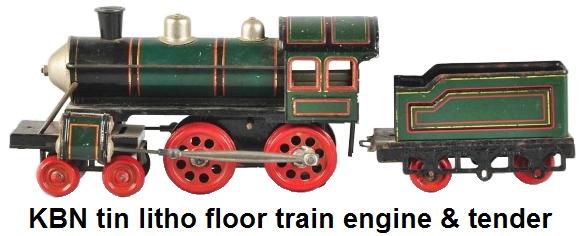 |
 |
 The early KBN products were very toy-like and were targeted for the lower end of the
market. Some clockwork trains only ran in forward and did not employ a brake. Windup keys were often
not removable. Locomotive wheels were made of pressed sheet metal. Bub was not offering a complete system,
but only train sets with an oval of track.
Bub trains never reached the quality of companies like Märklin which
was one of the most notable toy and model train manufacturers based in Germany. A partnership with
Issmayer and Carette allowed all three companies
to produce similar looking trains which often had only the logo that was different. Bub was one of
the first companies to produce die cast accessories for model trains. Many Bub toys reached the American
market via exclusive distributor F.A.O. Schwartz, New York City, during the 1920's-1930's.
The early KBN products were very toy-like and were targeted for the lower end of the
market. Some clockwork trains only ran in forward and did not employ a brake. Windup keys were often
not removable. Locomotive wheels were made of pressed sheet metal. Bub was not offering a complete system,
but only train sets with an oval of track.
Bub trains never reached the quality of companies like Märklin which
was one of the most notable toy and model train manufacturers based in Germany. A partnership with
Issmayer and Carette allowed all three companies
to produce similar looking trains which often had only the logo that was different. Bub was one of
the first companies to produce die cast accessories for model trains. Many Bub toys reached the American
market via exclusive distributor F.A.O. Schwartz, New York City, during the 1920's-1930's.
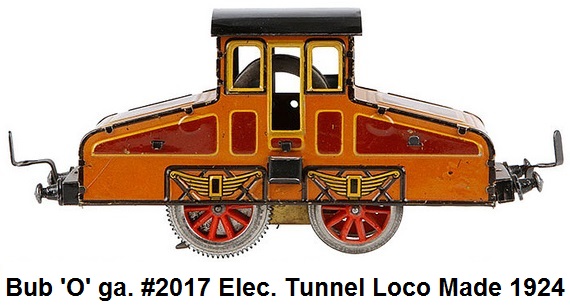 Albert and Emma's son, Heinz started working in the family business at an early age
and proved to be a talented toy designer in his own right. In the early 1920's, Bub cataloged
electric outline locomotives, some of which had
clock-work mechanisms that were patterned after contemporary German and Swiss prototypes. From 1925 on,
Bub introduced steam locomotives patterned after the standard German Reichsbahn prototypes. This included
small 0-4-0's through 2-4-2's and Atlantics to big Pacifics in 'O' gauge. The largest clockwork
locomotive manufactured by Bub was a 0-6-0, which caused a legal issue with Bing, as
they claimed the clockwork was an unauthorized copy of their product.
Albert and Emma's son, Heinz started working in the family business at an early age
and proved to be a talented toy designer in his own right. In the early 1920's, Bub cataloged
electric outline locomotives, some of which had
clock-work mechanisms that were patterned after contemporary German and Swiss prototypes. From 1925 on,
Bub introduced steam locomotives patterned after the standard German Reichsbahn prototypes. This included
small 0-4-0's through 2-4-2's and Atlantics to big Pacifics in 'O' gauge. The largest clockwork
locomotive manufactured by Bub was a 0-6-0, which caused a legal issue with Bing, as
they claimed the clockwork was an unauthorized copy of their product.
Starting in 1926 Bub introduced complete train sets in 24mm or 'OO' gauge. Both 2-rail and 3-rail versions were
available. The line included a series of accessories that were quite popular, especially the stations, which remained
catalogued from 1926-36. A station was included in each and every set sold. These Bub 'OO' gauge trains were not very detailed
and were primarily considered to be pure toys made for the enjoyment of children.

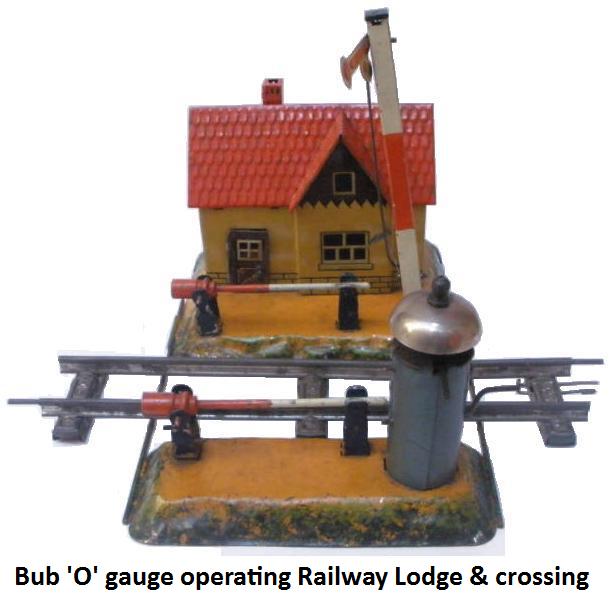 Bub also made some very unique
animated operating accessories in 'O' gauge, such as an operating turntable that paused a special clockwork locomotive after it
arrived on the turntable, rotated the table 180 degrees and then restarted the clockwork locomotive. Another item
was an operating railway lodge and crossing that as a train arrived would, chime a bell, lower a crossing arm,
switch a semaphore, stop and pause the clockwork locomotive, and then restart the train. A unique animated train
was the clockwork driven 'Whatsamatter' or pop-out train in 'O' gauge. This set consisted of an 0-4-0 locomotive, 4 wheel
tender and one little 4-wheel passenger car. There was a slot in the locomotive cab roof. When a track-trip stopped
the train, the engineer's head appeared through the roof to see why the train was delayed. After a short interval,
the head disappeared, and the train moved on. Around 1910 Bub issued a two train set that included 2 clockwork locomotives,
2 tenders, 3 freight wagons and 2 passenger coaches, but only a single loop of track was provided. The trains were
designed to run simultaneously on the same loop of track and were both
controlled/started/stopped in a novel manner by dual trackside semaphore accessories spaced equidistant from each
other. Completely synchronized automatic operation was facilitated, and neither train ever caught up with or
collided with the other.
Bub also made some very unique
animated operating accessories in 'O' gauge, such as an operating turntable that paused a special clockwork locomotive after it
arrived on the turntable, rotated the table 180 degrees and then restarted the clockwork locomotive. Another item
was an operating railway lodge and crossing that as a train arrived would, chime a bell, lower a crossing arm,
switch a semaphore, stop and pause the clockwork locomotive, and then restart the train. A unique animated train
was the clockwork driven 'Whatsamatter' or pop-out train in 'O' gauge. This set consisted of an 0-4-0 locomotive, 4 wheel
tender and one little 4-wheel passenger car. There was a slot in the locomotive cab roof. When a track-trip stopped
the train, the engineer's head appeared through the roof to see why the train was delayed. After a short interval,
the head disappeared, and the train moved on. Around 1910 Bub issued a two train set that included 2 clockwork locomotives,
2 tenders, 3 freight wagons and 2 passenger coaches, but only a single loop of track was provided. The trains were
designed to run simultaneously on the same loop of track and were both
controlled/started/stopped in a novel manner by dual trackside semaphore accessories spaced equidistant from each
other. Completely synchronized automatic operation was facilitated, and neither train ever caught up with or
collided with the other.
KBN Passenger Consists
In 1932, as a result of rising import custom taxes in Great Britain, Bub and Tipp & Co.
opened a second factory at Aylesbury in the UK with the name KB-Toy factory. This was a move to retain the
British market and to bypass UK anti-German import restrictions. This facility operated up until the
outbreak of World War II. Bub offered versions of its locomotives with removable pilots and single headlights in sets targeted at the
American Market. Some of the cars included in these sets were decorated with American road names. The
locomotives however were all adapted European body types. Not many
Bub products reached the U.S., so when they are discovered by collectors, they tend to be coveted quickly.
Bub had greater interest in the British market, than in the American market. Even
before the factory in England was established, there were several train sets issued in liveries of British
railway companies such as LNWR and GN. After the British Railway merger of 1923, LNER and LHS liveries
were issued.

Bub acquired the tooling for Bing toy trains when Bing went
out of the model train business in 1932. Bing's table top 'OO' gauge railroad had been a big success with
consumers so Bub continued to manufacture the 'OO' gauge railway for about 2 years. The Bing 'OO' system was the
first to ever be produced in that gauge, starting in the early 1920's, under the auspices of Bassett-Lowke.
Bub abandoned its own line of 24mm track products in favor of the very successful Bing products. The former Bing tender locomotive
and passenger cars were given a new lithography scheme, but otherwise were unchanged while produced by Bub. Eventually the
Bing designed toy train system was replaced by a newly developed 'OO' gauge Bub product, but without
these trains or track being inter-changeable, and only train sets with an oval of track were made available. Locomotives were
available in both clockwork and electrically powered versions.
Besides the dies, Bub used the toy sales organization of Bing, a fact which explains why many of the later products sold had the combined
trademarks of both companies. Bub even continued to utilize the Bing numbering system for the former Bing products it produced through 1936.
 The cover of the Bub 1937 catalogue was adorned with the newly introduced 'Fliegende Hamburger' or
Flying Hamburger high speed rail car in 'OO' gauge. This is one of the rarest trains ever produced by Bub, and an actual
one was not located until the year 2000, as a flea market find. The railcar was beautifully lithographed in cream and purple and was a very good
overall model of the prototype, the DRG Class SVT 877 Hamburg Flyer. Originally entering service in 1933 this was Germany's
first fast diesel-electric train, and is credited with establishing the fastest regular railway connection in the world in its time.
Correctly named the Baureihe SVT 877 (later DB Baureihe VT 04 000 a/b), the diesel-electric powered train was used to carry
passengers on the Berlin–Hamburg line (roughly 286 km or 178 mi). The Bub model was powered by a Bing designed motor that
underwent modifications to the brush arrangment in order to fit in the railcar. It was available as a 42 cm long 2-car version
or as a 59 cm long 3 car version. A shorter (28 cm), 2-car clockwork version was issued later in 1938-39.
The cover of the Bub 1937 catalogue was adorned with the newly introduced 'Fliegende Hamburger' or
Flying Hamburger high speed rail car in 'OO' gauge. This is one of the rarest trains ever produced by Bub, and an actual
one was not located until the year 2000, as a flea market find. The railcar was beautifully lithographed in cream and purple and was a very good
overall model of the prototype, the DRG Class SVT 877 Hamburg Flyer. Originally entering service in 1933 this was Germany's
first fast diesel-electric train, and is credited with establishing the fastest regular railway connection in the world in its time.
Correctly named the Baureihe SVT 877 (later DB Baureihe VT 04 000 a/b), the diesel-electric powered train was used to carry
passengers on the Berlin–Hamburg line (roughly 286 km or 178 mi). The Bub model was powered by a Bing designed motor that
underwent modifications to the brush arrangment in order to fit in the railcar. It was available as a 42 cm long 2-car version
or as a 59 cm long 3 car version. A shorter (28 cm), 2-car clockwork version was issued later in 1938-39.
KBN 4-wheel 'O' gauge Freight Wagons
In 1934 Bub released an impressive series of lithographed 8-wheel freight cars.
The lithography treatment of the livery on these cars was not prototypical but used great colors, graphics
and stylings. Each car bore the name of a different city in Germany, but it is believed that these cars were
made for the US, British and Canadian markets as well.
KBN Large 8-wheel Freight Wagons
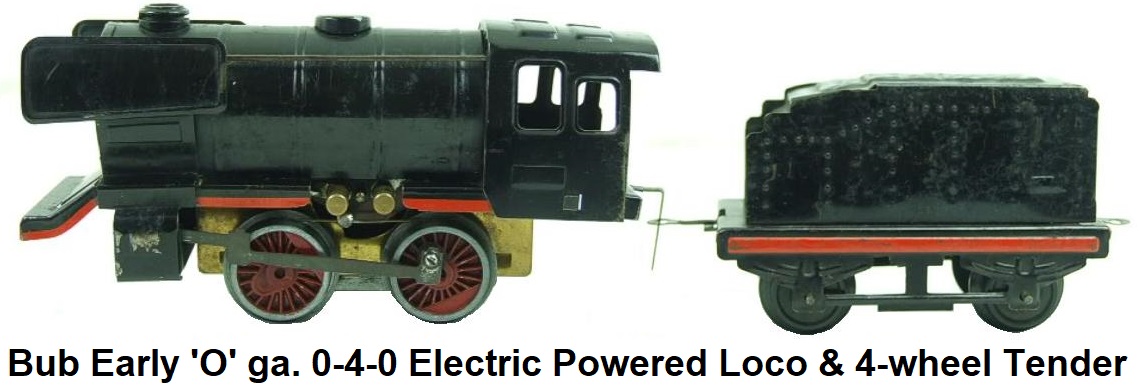 Bub was able to keep manufacturing costs low during the depression era because
it utilized paper thin sheet metal. Bub restarted production of the Bing models in 1934 for the
German market but this in turn ceased at the outbreak of World War II. Models made from Bing's dies
appear in catalogs issued from the beginning of the 1930's and most are freight cars of the later Bing
types. During that time period it was fairly common for tinplate train manufacturers to copy each other's
designs, and the similarity of Bing, Fandor and Ives
freight and passenger cars in the Bub 'O' gauge lines is apparent. Albert Huck passed away in 1938, and Heinz
inherited the family toy business. The original Bub factory in Nüremberg was completely destroyed
during the war along with a large historical collection of Bub toys.
Bub was able to keep manufacturing costs low during the depression era because
it utilized paper thin sheet metal. Bub restarted production of the Bing models in 1934 for the
German market but this in turn ceased at the outbreak of World War II. Models made from Bing's dies
appear in catalogs issued from the beginning of the 1930's and most are freight cars of the later Bing
types. During that time period it was fairly common for tinplate train manufacturers to copy each other's
designs, and the similarity of Bing, Fandor and Ives
freight and passenger cars in the Bub 'O' gauge lines is apparent. Albert Huck passed away in 1938, and Heinz
inherited the family toy business. The original Bub factory in Nüremberg was completely destroyed
during the war along with a large historical collection of Bub toys.

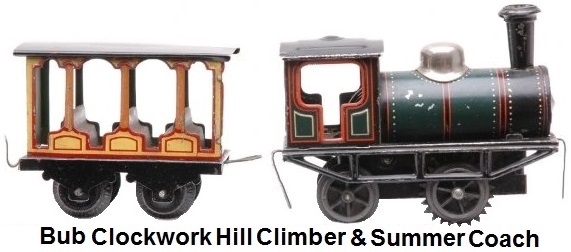 After 1945, in addition to continuing 'O' gauge trains manufacture,
a new production of 2 rail DC and clockwork powered trains in an 'S'
like gauge (1:66 scale running on 24 mm track) with tubular track was created. These trains were made of tinplate.
The electric locomotives featured open frame 18V DC motors. The range was fairly wide and included both freight and passenger wagons.
Locomotives ranged from the simple 0-4-0 Tank to more complex 4-8-4 tender locos and even a cog railway loco. The Bub 'S' gauge
trains were not compatible with 'S' gauge American Flyer track, as Bub Spur S is 24 mm and American Flyer is 22.5 mm between the rails
(0.883 inches). Bub engineers had made an error when converting from inches to millimeters.
Unfortunatley, these train products could not compete with the upcoming trend of HO gauge and turned out to be a commercial
failure in Germany.
After 1945, in addition to continuing 'O' gauge trains manufacture,
a new production of 2 rail DC and clockwork powered trains in an 'S'
like gauge (1:66 scale running on 24 mm track) with tubular track was created. These trains were made of tinplate.
The electric locomotives featured open frame 18V DC motors. The range was fairly wide and included both freight and passenger wagons.
Locomotives ranged from the simple 0-4-0 Tank to more complex 4-8-4 tender locos and even a cog railway loco. The Bub 'S' gauge
trains were not compatible with 'S' gauge American Flyer track, as Bub Spur S is 24 mm and American Flyer is 22.5 mm between the rails
(0.883 inches). Bub engineers had made an error when converting from inches to millimeters.
Unfortunatley, these train products could not compete with the upcoming trend of HO gauge and turned out to be a commercial
failure in Germany.

With little marketplace acceptance for the S gauge products, after a 10 year period
Bub turned to producing cheap HO gauge trains. At this point in time during the mid 1950's customer demand for
model and toy trains was for more realistic scale HO gauge
model railways. The first known advertisements for new HO scale trains by Bub called 'H Series' started to appear around October 1958.
Two different types of Bub 'H series' offerings were created. These were complete sets and individually packaged trains. Locomotives were
either clockwork or battery drive powered. Rolling stock included passenger and freight cars with automatic coupling/uncoupling capabilities using
simple hook/eye couplers initially made of sheet metal but later converted to plastic. Cars featured details such as axle boxes
or bogie panels, and buffers but detailing of the bodies was minimal. The electric battery powered locos ran on 4.5V DC motors, but could be converted to run
on track power with 14V motors, and a #1925 transformer for connection to home 110/220V power was offered. The packaged sets included all necessary
components to build a circular or oval track layout.
The first locomotives offered were models of the V 200 diesel-hydraulic express locomotive of the German Deutsche Bundesbahn
and the steam locomotive BR 10 modern express train also of the DB. The V 200 was the only Bub HO locomotive made entirely of lithographed sheet
metal. All other locomotives had plastic molded bodies. Other locomotives produced included a #1420 Baldwin Diesel made 1959-1960, a #1430
Br 80 026 of the DB from 1959, a #1444 Bo-Bo DE 2200 of the NS from 1960, a #1450 V 80 014 of the DB from 1960, and a #1467 Br 24 460 of the DB
circa 1962. Bub mainly sold these HO products through toy wholesalers such as FCW in Switzerland. A small portion were offered
through mail order companies such as Quelle, Neckarmann, Schöpflin, Bauer and Schwab. And some were distributed through
department stores like Karstadt, Kaufhof, Migros (Switzerland) and V & D (Netherlands). Acceptance of these Bub HO products with
the purists of the HO scale modelling world was not favorable. In 1963 Bub collaborated with HWN (Heinrich Wimmer Nuremberg) to
produce a more scale-like BR24 locomotive and tender.
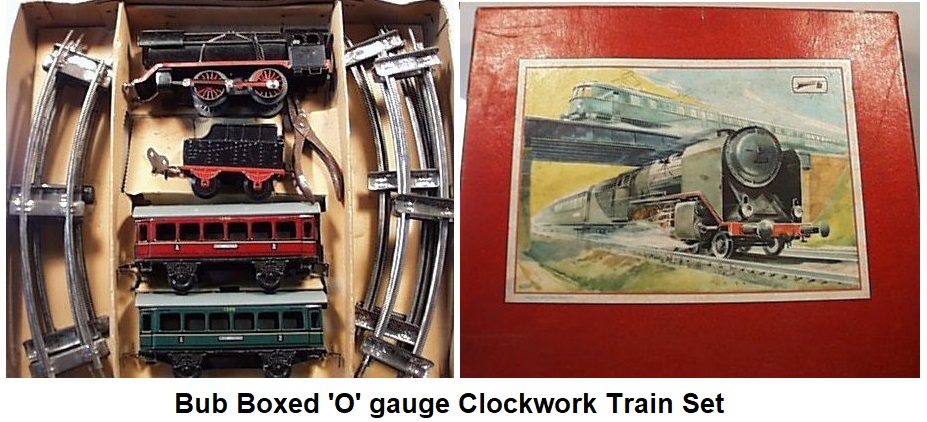 The company struggled to recapture its earlier successes by creating the popular BubMobil.
During the 1950´s the company made a strategic error by not switching its production from die cast and tinplate
to plastic, as was the practice held by other toy train manufacturers of the time. By the mid 1960´s Bub
was forced to completely cease production and cease operations. In 1964, the factory was located
at Elsnerstrasse 9, near the original one. There was a plan to convert to the manufacture of HO gauge
and N gauge locomotives with experimental vibrator motor drives designed by Heinz Huck, but the company
itself wound up closing its doors in 1966.
The company struggled to recapture its earlier successes by creating the popular BubMobil.
During the 1950´s the company made a strategic error by not switching its production from die cast and tinplate
to plastic, as was the practice held by other toy train manufacturers of the time. By the mid 1960´s Bub
was forced to completely cease production and cease operations. In 1964, the factory was located
at Elsnerstrasse 9, near the original one. There was a plan to convert to the manufacture of HO gauge
and N gauge locomotives with experimental vibrator motor drives designed by Heinz Huck, but the company
itself wound up closing its doors in 1966.
Bub trains and cars are hard to find and are highly collectible. Since the early
trains were made very cheaply, they were typically played with until they broke, and then were thrown
away by their owners. Complete sets of these trains rarely
appear on the market except at auction when an old established collection is being dispersed.
Catalogs issued by Bub are very rare because, in common with other Nüremberg manufacturers,
these were issued only to retailers.
In 2002 a new firm began producing HO and large scale trains under the Bub name.
There is no lineal
connection between the old Bub and the new Bub. The new products are manufactured in China, but the
company offices are located in Nüremberg. Their web site address is www.bub-toys.de.
KBN 40 CM Large 8-wheel Coaches
Back To Top of Page

